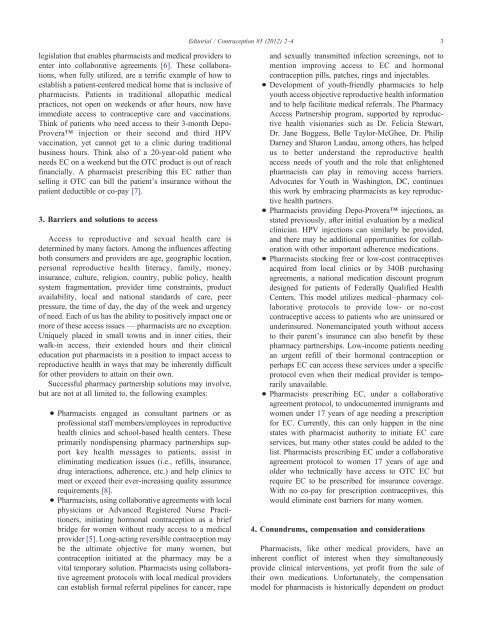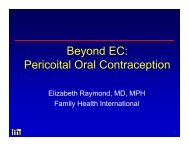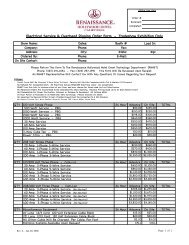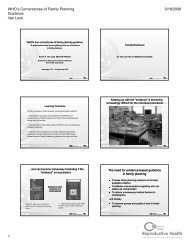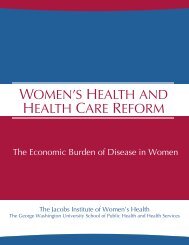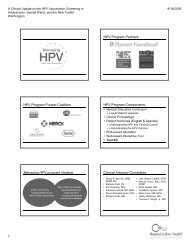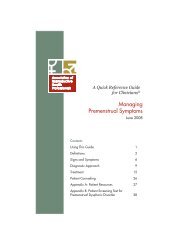Inviting the pharmacist: a model for improved reproductive care access
Inviting the pharmacist: a model for improved reproductive care access
Inviting the pharmacist: a model for improved reproductive care access
Create successful ePaper yourself
Turn your PDF publications into a flip-book with our unique Google optimized e-Paper software.
Editorial / Contraception 85 (2012) 2–43legislation that enables <strong>pharmacist</strong>s and medical providers toenter into collaborative agreements [6]. These collaborations,when fully utilized, are a terrific example of how toestablish a patient-centered medical home that is inclusive of<strong>pharmacist</strong>s. Patients in traditional allopathic medicalpractices, not open on weekends or after hours, now haveimmediate <strong>access</strong> to contraceptive <strong>care</strong> and vaccinations.Think of patients who need <strong>access</strong> to <strong>the</strong>ir 3-month Depo-Provera injection or <strong>the</strong>ir second and third HPVvaccination, yet cannot get to a clinic during traditionalbusiness hours. Think also of a 20-year-old patient whoneeds EC on a weekend but <strong>the</strong> OTC product is out of reachfinancially. A <strong>pharmacist</strong> prescribing this EC ra<strong>the</strong>r thanselling it OTC can bill <strong>the</strong> patient's insurance without <strong>the</strong>patient deductible or co-pay [7].3. Barriers and solutions to <strong>access</strong>Access to <strong>reproductive</strong> and sexual health <strong>care</strong> isdetermined by many factors. Among <strong>the</strong> influences affectingboth consumers and providers are age, geographic location,personal <strong>reproductive</strong> health literacy, family, money,insurance, culture, religion, country, public policy, healthsystem fragmentation, provider time constraints, productavailability, local and national standards of <strong>care</strong>, peerpressure, <strong>the</strong> time of day, <strong>the</strong> day of <strong>the</strong> week and urgencyof need. Each of us has <strong>the</strong> ability to positively impact one ormore of <strong>the</strong>se <strong>access</strong> issues — <strong>pharmacist</strong>s are no exception.Uniquely placed in small towns and in inner cities, <strong>the</strong>irwalk-in <strong>access</strong>, <strong>the</strong>ir extended hours and <strong>the</strong>ir clinicaleducation put <strong>pharmacist</strong>s in a position to impact <strong>access</strong> to<strong>reproductive</strong> health in ways that may be inherently difficult<strong>for</strong> o<strong>the</strong>r providers to attain on <strong>the</strong>ir own.Successful pharmacy partnership solutions may involve,but are not at all limited to, <strong>the</strong> following examples:• Pharmacists engaged as consultant partners or asprofessional staff members/employees in <strong>reproductive</strong>health clinics and school-based health centers. Theseprimarily nondispensing pharmacy partnerships supportkey health messages to patients, assist ineliminating medication issues (i.e., refills, insurance,drug interactions, adherence, etc.) and help clinics tomeet or exceed <strong>the</strong>ir ever-increasing quality assurancerequirements [8].• Pharmacists, using collaborative agreements with localphysicians or Advanced Registered Nurse Practitioners,initiating hormonal contraception as a briefbridge <strong>for</strong> women without ready <strong>access</strong> to a medicalprovider [5]. Long-acting reversible contraception maybe <strong>the</strong> ultimate objective <strong>for</strong> many women, butcontraception initiated at <strong>the</strong> pharmacy may be avital temporary solution. Pharmacists using collaborativeagreement protocols with local medical providerscan establish <strong>for</strong>mal referral pipelines <strong>for</strong> cancer, rapeand sexually transmitted infection screenings, not tomention improving <strong>access</strong> to EC and hormonalcontraception pills, patches, rings and injectables.• Development of youth-friendly pharmacies to helpyouth <strong>access</strong> objective <strong>reproductive</strong> health in<strong>for</strong>mationand to help facilitate medical referrals. The PharmacyAccess Partnership program, supported by <strong>reproductive</strong>health visionaries such as Dr. Felicia Stewart,Dr. Jane Boggess, Belle Taylor-McGhee, Dr. PhilipDarney and Sharon Landau, among o<strong>the</strong>rs, has helpedus to better understand <strong>the</strong> <strong>reproductive</strong> health<strong>access</strong> needs of youth and <strong>the</strong> role that enlightened<strong>pharmacist</strong>s can play in removing <strong>access</strong> barriers.Advocates <strong>for</strong> Youth in Washington, DC, continuesthis work by embracing <strong>pharmacist</strong>s as key <strong>reproductive</strong>health partners.• Pharmacists providing Depo-Provera injections, asstated previously, after initial evaluation by a medicalclinician. HPV injections can similarly be provided,and <strong>the</strong>re may be additional opportunities <strong>for</strong> collaborationwith o<strong>the</strong>r important adherence medications.• Pharmacists stocking free or low-cost contraceptivesacquired from local clinics or by 340B purchasingagreements, a national medication discount programdesigned <strong>for</strong> patients of Federally Qualified HealthCenters. This <strong>model</strong> utilizes medical–pharmacy collaborativeprotocols to provide low- or no-costcontraceptive <strong>access</strong> to patients who are uninsured orunderinsured. Nonemancipated youth without <strong>access</strong>to <strong>the</strong>ir parent's insurance can also benefit by <strong>the</strong>sepharmacy partnerships. Low-income patients needingan urgent refill of <strong>the</strong>ir hormonal contraception orperhaps EC can <strong>access</strong> <strong>the</strong>se services under a specificprotocol even when <strong>the</strong>ir medical provider is temporarilyunavailable.• Pharmacists prescribing EC, under a collaborativeagreement protocol, to undocumented immigrants andwomen under 17 years of age needing a prescription<strong>for</strong> EC. Currently, this can only happen in <strong>the</strong> ninestates with <strong>pharmacist</strong> authority to initiate EC <strong>care</strong>services, but many o<strong>the</strong>r states could be added to <strong>the</strong>list. Pharmacists prescribing EC under a collaborativeagreement protocol to women 17 years of age andolder who technically have <strong>access</strong> to OTC EC butrequire EC to be prescribed <strong>for</strong> insurance coverage.With no co-pay <strong>for</strong> prescription contraceptives, thiswould eliminate cost barriers <strong>for</strong> many women.4. Conundrums, compensation and considerationsPharmacists, like o<strong>the</strong>r medical providers, have aninherent conflict of interest when <strong>the</strong>y simultaneouslyprovide clinical interventions, yet profit from <strong>the</strong> sale of<strong>the</strong>ir own medications. Un<strong>for</strong>tunately, <strong>the</strong> compensation<strong>model</strong> <strong>for</strong> <strong>pharmacist</strong>s is historically dependent on product


